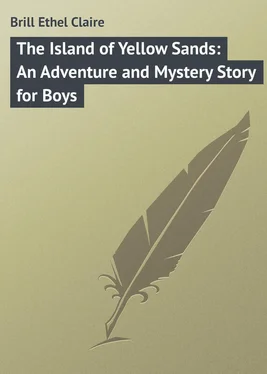Ethel Brill - The Island of Yellow Sands - An Adventure and Mystery Story for Boys
Здесь есть возможность читать онлайн «Ethel Brill - The Island of Yellow Sands - An Adventure and Mystery Story for Boys» — ознакомительный отрывок электронной книги совершенно бесплатно, а после прочтения отрывка купить полную версию. В некоторых случаях можно слушать аудио, скачать через торрент в формате fb2 и присутствует краткое содержание. Жанр: foreign_prose, Прочие приключения, foreign_language, на английском языке. Описание произведения, (предисловие) а так же отзывы посетителей доступны на портале библиотеки ЛибКат.
- Название:The Island of Yellow Sands: An Adventure and Mystery Story for Boys
- Автор:
- Жанр:
- Год:неизвестен
- ISBN:нет данных
- Рейтинг книги:4 / 5. Голосов: 1
-
Избранное:Добавить в избранное
- Отзывы:
-
Ваша оценка:
- 80
- 1
- 2
- 3
- 4
- 5
The Island of Yellow Sands: An Adventure and Mystery Story for Boys: краткое содержание, описание и аннотация
Предлагаем к чтению аннотацию, описание, краткое содержание или предисловие (зависит от того, что написал сам автор книги «The Island of Yellow Sands: An Adventure and Mystery Story for Boys»). Если вы не нашли необходимую информацию о книге — напишите в комментариях, мы постараемся отыскать её.
The Island of Yellow Sands: An Adventure and Mystery Story for Boys — читать онлайн ознакомительный отрывок
Ниже представлен текст книги, разбитый по страницам. Система сохранения места последней прочитанной страницы, позволяет с удобством читать онлайн бесплатно книгу «The Island of Yellow Sands: An Adventure and Mystery Story for Boys», без необходимости каждый раз заново искать на чём Вы остановились. Поставьте закладку, и сможете в любой момент перейти на страницу, на которой закончили чтение.
Интервал:
Закладка:
“Gens de Terre,” the boy exclaimed. “These are the shores where they belong. They seldom go as far south as the Sault. Some call them Men of the Woods. They are dirty, but very honest. The traders say it is always safe to give them credit, for rarely does one of them fail to pay in full. They are good tempered too, but when food is scarce I have heard they sometimes turn Windigo.” The lad shuddered and crossed himself. Windigo is the Indian name for a man who has eaten human flesh and has learned to like it. Both Indians and white men believed that such a savage was taken possession of by a fiend. Men suspected of being Windigos were shunned and feared by red men and white alike.
The voyageurs made a traverse of several miles, and ran among a cluster of little islands abreast of Pic Island, a rock peak rising about seven hundred feet from a partly submerged ridge. Fog, blown by a raw, gusty wind delayed them considerably that day. After running on a hidden rock and starting a seam in the canoe, they were finally compelled to camp on a rock islet near shore. There they dined on blueberries, and slept on thick beds of moss and low growing blueberry and bearberry plants.
The following day, after a sharp north wind had driven away the fog, they went on, and passed the Slate Islands, high and blue, seven or eight miles across the water. At supper time they entered a little cove, where they were horrified to find signs of a recent tragedy. A canoe was floating bottom up, the beach at the head of the cove was strewn with pelts, the sand trampled and blotched with dark patches. Near by were the ashes of a camp-fire.
Nangotook looked the place over carefully, then remarked, “Awishtoya been here.”
“Why do you say that?” exclaimed Jean. “What makes you think so?”
“Trapper going to Pic with winter’s catch,” the Indian explained. “Awishtoya found him, attacked him, killed him maybe,” and he pointed to the blood stains in the sand. “Broke open his packs and took best furs. These no good,” touching one of the abandoned skins with his foot.
“Something of the kind must have happened here,” Ronald agreed, “and Le Forgeron would not be above such a deed. Do you see anything to prove he did it, Etienne?”
The Ojibwa shook his head. “No need to prove it,” he said. “Awishtoya came this way. Always there are evil deeds where he goes.”
From the ashes of the fire and the condition of the sand, the Indian thought the deed a recent one, committed not longer ago than the night before, perhaps that very day. The three righted the canoe, but found nothing about it to show its owner. Though they searched the shores of the cove, they did not discover the body of the murdered man, if he had been murdered, or any further traces of him or of the man or men who had attacked him. The marks in the sand were so confused, indicating a desperate struggle, that not much could be read from them, but Nangotook thought there had been at least three men in the affray.
The boys had no desire to linger in the cove. As soon as the evening meal was over, they launched their canoe, and traveled far into the night, most of the time against a troublesome head wind. Near the entrance to what is now called the North Channel, which leads into Nipigon Bay, they made camp.
The lads were growing very impatient. It seemed to them they never would reach the Rock of the Beaver, as Nangotook had called the spot where they were to strike south across the open lake. They were beginning to wonder if he were taking them clear back to Grande Portage, for they had now come considerably more than two-thirds of the way. Up to that time the Ojibwa had given them no hint of the location of the Rock, except to say that it was on the north shore, but that night he volunteered some information. “Only one day more,” he said, “one good day.”
VII
THE ROCK OF THE BEAVER
The next morning at dawn the sky was mottled with scudding clouds driven by an east wind. The prospect was not promising, but the wind was in the right direction for sailing, and the voyageurs put out in haste, rigging their blanket sail. It was their intention to pass outside the islands that almost block the entrance to Nipigon Bay. They made good time before the breeze, though the waves followed the frail craft perilously, and the three were soon well soaked with cold spray. But the wind changed to the southeast, and dark blue clouds, with slanting lines of rain below them, began to roll up. The sail had to be lowered, and, as the wind increased and blew in gusts and squalls, it took all the canoemen’s skill to keep from swamping before they gained the eastern end of the great Island of St. Ignace.
There they were glad to run into a long bay or cove, protected by high peaks and ridges on either side and by a small island at the entrance and another large one, now known as Simpson’s Island, across a narrow channel to the east. To the head of the cove, where a small stream entered it, they paddled, and found a landing place. There they stowed the supplies under the canoe, placing them on poles and paddles to keep them off the wet ground, for rain had begun to fall.
Making camp in the rain is an unpleasant task, but they needed a better shelter than the small canoe would afford. So they left the beach, and explored the woods for a good spot where they could build a lodge in the Indian fashion. A considerable distance back from the water, Etienne found, at last, a spot level and open enough.
Ronald and Jean cleared the ground, while the Indian cut young birch trees and stripped larger ones of their bark. Ronald was expert with an ax and wasted no blows. Bending a sapling over with his left hand, he gave it a sharp clip, then bending it the other way, another quick stroke, and it was down. Bushes were cut or pulled up, loose rocks thrown to one side, troublesome roots grubbed up, and hummocks leveled with vigorous strokes of the back of the ax. In an incredibly short time the camping ground was fairly smooth and level. Then Nangotook set up a frame, thrusting the butts of the trees he had cut into the ground, and bending together and interlacing the tops. This framework he and the boys covered with sheets of birch bark, “wig-wass” Nangotook called the bark. They did not take time to sew the pieces together, but overlapped them and placed more poles against them to keep them in place. The ground within the lodge, or “wigwam,” as the Ojibwa called it, was hastily strewn with spruce branches. The shelter was completed none too soon. Just as Jean was carrying in an armful of the gray moss or lichen that almost covered many of the spruce trees, hanging down from them and giving them the appearance of being bearded with age, there came a wild burst of rain and hail that rattled on the bark walls like bullets.
The rest of that day and night and most of the next day rain fell with scarcely a pause. The disgusted gold-seekers were compelled to remain within shelter, going out only long enough to cut wood for the fire and to catch a few fish.
Late in the afternoon the rain ceased, and the gray clouds showed signs of breaking. Hares seemed to be plentiful on the island, and Etienne went out to set some snares, while the two boys climbed up through the dripping woods, over slippery moss and rocks, to a spot where they could see out over the lake. The water was still rough, but the wind had shifted to the north and gave promise of clearing weather. They hoped they might be able to go on by morning. According to Etienne the Rock of the Beaver was only a half day’s journey away.
On their way back to camp they came suddenly within range of a plump hare that was feeding on a large red mushroom. Ronald, who was on the lookout for game, made a lucky shot. Though hare flesh is not at its best while the animal still wears his gray-brown summer coat, the fresh meat was more than welcome to the voyageurs. There was other game on the island, for they saw tracks, half washed out by the rain, that Jean was sure were those of caribou, and the Indian said there were moose prints in a boggy place near where he set his snares. When the boys went down to the bay for water, they found signs that both mink and marten had been there before them, and in the night they were awakened several times by the sharp, cat-like snarl of a lynx. They found no indications that any one had trapped in the vicinity the winter before, however.
Читать дальшеИнтервал:
Закладка:
Похожие книги на «The Island of Yellow Sands: An Adventure and Mystery Story for Boys»
Представляем Вашему вниманию похожие книги на «The Island of Yellow Sands: An Adventure and Mystery Story for Boys» списком для выбора. Мы отобрали схожую по названию и смыслу литературу в надежде предоставить читателям больше вариантов отыскать новые, интересные, ещё непрочитанные произведения.
Обсуждение, отзывы о книге «The Island of Yellow Sands: An Adventure and Mystery Story for Boys» и просто собственные мнения читателей. Оставьте ваши комментарии, напишите, что Вы думаете о произведении, его смысле или главных героях. Укажите что конкретно понравилось, а что нет, и почему Вы так считаете.












